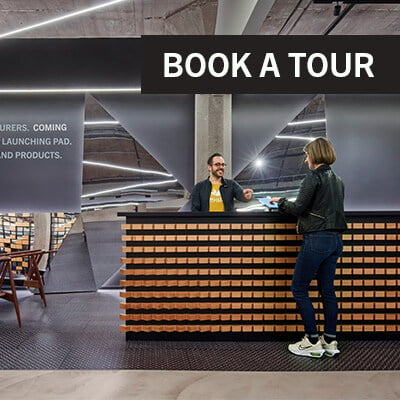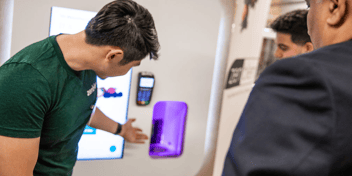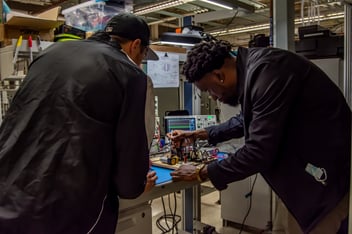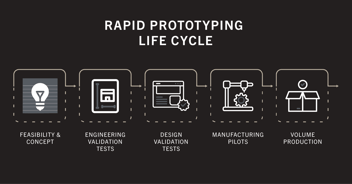What is market testing?
Market testing is a set of actions taken in an effort to gain clarity on the real need for your product by your target market. Think about the problem you’re trying to solve - if your product doesn’t solve a problem, you won’t sell it.
You are a product innovator trying to commercialize your hardtech while also trying to avoid burning through the limited money, time, and other finite resources at your disposal. You want your startup to turn a profit (granted - profits won't come in until year 2 or 3), so you must figure out how to get your product into the right people's hands.
What is the key to getting your product into the right people's hands? You must spend time engaging in customer discovery and compiling market research. In this article you’ll learn how to break the product engineering vision “if I build it, they will come.” In fact, it’s really not about your product at all. It’s about the customer.
Engaging in Customer Discovery
Customer discovery requires founders to do market research for the product they’re developing. Market research typically involves qualitative and quantitative research. Qualitative research helps you build a deep understanding of use cases and customer needs that drive product development. Quantitative research helps you understand your market, the competition, and it helps validate assumptions – in some cases, mitigating personal biases during the product development cycle. Using qualitative and quantitative research, founders can generate meaningful insights that help them understand how to serve their target customers better.
The key is to make sure you approach every interaction with empathy for the user’s experience. Take Starbucks for example. In 2008, they rolled out their ‘splash sticks’ - those little green plastic pieces that fit snugly into the sip opening of the coffee lid. Why? Because they care enough about their customers’ experience that they created a new product to enhance their existing offering. They understood that their potential customers might not purchase coffee out of fear of spilling / staining their clothing, so Starbucks made that buying decision easier by including the splash sticks to solve this pain point in the user experience. This is a great example of the impact qualitative research can have on product development. Qualitative research means going out and observing people in real-life situations so you can get a deeper understanding of your customers' actual experience and uncover their unmet needs.
For example, let’s say you are developing a bath time product for babies. You might already have assumptions about what product features you think you need, but until you visit a hundred people and observe their real-life experience bathing babies, you won’t really know for sure what those folks are truly experiencing. How do they do it? What are the steps involved? What are the actions they take? What obstacles are presented during the activity? How does the user get around the obstacles to achieve their objective? What are the real pain points you observe? Maybe your initial idea was for a product that the baby engages with while in the bathtub, but during observation process, you uncover the issues around getting the baby into the bathtub. Understanding your target customers’ real-life experiences, challenges, and existing workarounds can provide some key insights to inspire truly innovative products that will disrupt the marketplace.
When should I test the market validity of a product?
Market testing should be done early in the product development process. “You have to determine whether your product is solving a real problem,” explains Thierry Van Landegem, Executive Director of the mHUB Accelerator for Sustainable Manufacturing and Energy Tech cohorts. “Testing in the early stages is validating that your product idea is really solving the problem.”
Because you must determine whether your product is going to sell well enough to cover manufacturing and distribution costs, it’s critical to test the market on the idea, on the prototype, and on the initial product, BEFORE any form of production even begins.
Before you approach people - this point cannot be emphasized enough - make sure your target customer is testing the solution. If the wrong target market is testing your solution, they won't give you feedback that is valuable to that market.
Here are some ways you can approach people in an effort to gather customer feedback:
- Identify who you think your customer is and tap into your network to see if you can find those people. Ask for introductions so you can schedule some customer discovery interviews. Tap into the network of your network.
- Look into associations and clubs. Use that path to access your potential customer. Don’t know what industry clubs or trade associations exist in your vertical? Do some research online or look through LinkedIn Groups to find where your target end users can be accessed.
- If you are going to try “cold” phone calls or emails, write a script. Consumers don’t want to speak to salespeople, so it’s best to explain that you are doing research and you’d like to learn more about their experience and how they might use your product. People are naturally inclined to help one another, so asking for 20 minutes of their time to get some feedback will often illicit a positive response.
- Consider sending surveys and questionnaires, either online, through a survey platform, or via email or phone call. Tell the user how much time it will take them up front. Offer incentives for completing the survey (maybe a future 5% off discount for your product). Be concise. Communicate the benefit to them before asking them to take action.
- Organize a focus group. Focus groups can be a great way to get a lot of customer interviews / insights all at once. Focus groups can include a discussion about their experience solving a current problem (products they’re already using and what doesn’t work with those existing solutions) or solutions they wish existed. In some cases, you could ask people in the focus groups to interact with your product and observe actual use of your product en masse.
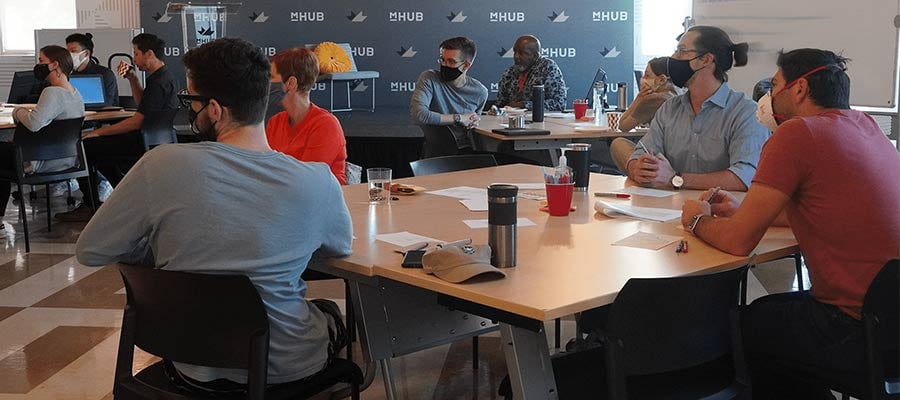
Physically interfacing with your early-stage prototype
Now that you know the ways you can find and ask people to help you with market testing, what should you be doing during the market testing session where your target customers are physically interfacing with your early-stage prototype?
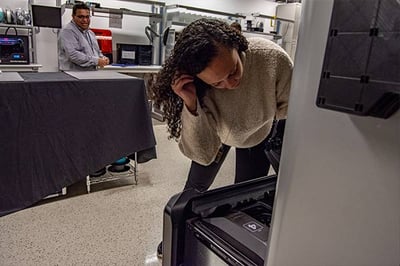 Before determining your goals for the interaction, commit to sitting back and observing. It’s very important that during the in-person test session that you don’t “lead” the person to talk or behave in any way that you want them to. This testing session is about observing real people and their most authentic interaction with your early-stage prototype.
Before determining your goals for the interaction, commit to sitting back and observing. It’s very important that during the in-person test session that you don’t “lead” the person to talk or behave in any way that you want them to. This testing session is about observing real people and their most authentic interaction with your early-stage prototype.
Your test session goals might be to see if the person is using your product the way it’s intended to be used. You might have one session where you see how one person interacts with the product, and organize an entirely separate session where you watch how multiple people interact with the product together at the same time – maybe one of your goals is to see what effect group dynamics has on product use/engagement.
If during the testing session you observe that a person is using your prototype in a way you didn't expect, you should document how they are using it. That documentation might offer you insights during the analysis of your test session data about how you might change the way you're positioning the product.
In a test session, you might stage a shopping experience where your product is in a piece of packaging on a shelf. You might ask them to pick up the package and observe what pictures or pieces of information on the packaging really stand out to them. What details are they noticing? What stands out? In a good way? In a bad way? Have them open the package in front of you. Are they looking for instructions to fall out of the box? Are they looking for concise step-by-step instructions listed on the outside of the packaging?
During observation, don’t ask leading questions. Ask vague, open-ended questions. Ask questions like, “tell me what you see”, “tell me about your experience”, "Can you elaborate on that point"? Try to avoid looking for answers to your specific questions. This is about the users’ experience. While the person(s) are interacting with your product, you may discover a new need because they're using your minimium viable product differently than you originally intended.
If you are going to design a market testing period where several users are allowed to use your product over a period of several weeks, plan ahead about how you will collect the information you need - I.e. their frequency of product use, their experience of use of that product over time, and other use case details you with which you want insights.
Customer feedback on your MVP, prototype, or initial product doesn’t always answer all the questions you might have to maximize the scope of everyone who wants to buy it, but it does help you hone in on the true pain point(s) your target customers have – this allows you to validate the possible solution for a specific problem.
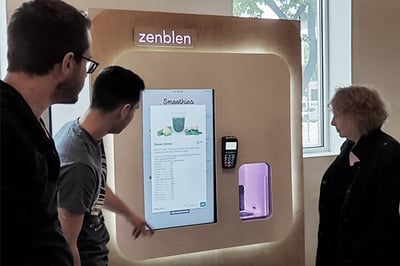
Demand Validation helps you understand Product Market Fit and Build a Customer Value Proposition
Validating demand involves identifying the true pain point(s) your target customers have and validating the possible solution for that problem. After doing customer discovery and putting yourself through their journey and experience, now you can truly understand your customer, their pain point, and realize the actual deeper need – which should inform the hardtech solution you’re developing. Now that you have done the research, you can determine if your solution is still a physical product, software-enabled hardtech, or a product combined with a service.
Sketch an idea for your solution or use very frugal initial tools to define your solution. Use simple materials, like cardboard for example, to test and validate. Keep iterating on your hardtech solution to validate demand and confirm product market fit. Knowing the problem and validating the solution for the job that needs to be done is how you build a Customer Value Proposition (i.e. tell the customer you understand their problem and communicate the value customers can gain through your product / service).
Pitfalls that startups face during the market testing and demand validation phases
Creators fall in love with their ideas. This can lead to asking the wrong questions during customer interviews. To avoid this, ask very open-ended questions - making sure you capture all of what is to be captured instead of hearing what you want to hear.
Don’t ask your family and friends about your product – they love you and will say it’s great even if it’s not.
Avoid trying to build the “final” product. Make the minimum viable product to make sure you’re on the right path. Be frugal. Developing hardtech takes time, so be careful not to burn through all your initial resources.
Founders can collect market testing data but can sometimes stumble in the parsing of that data. When you’re creating your market testing plans, make sure you have a solid grasp on the key pieces of information you’re collecting and how those data points help to answer your open questions. Some companies specialize in outreach, data collection, and qual/quant analysis, but if you’re a founder with a small operating budget, hiring a third party to do this critical work might not be feasible. Do some homework and make a plan to execute. It’s better to do too much validation than not enough. Remember, you don’t want to spend time and money building a product for a market where there is no demand.
Market Testing & Demand Validation Journey
As you evolve from building a prototype to building a product, you’ll go on a journey through iterative prototyping, repeated market testing and demand validation, strengthening your customer value proposition, If you're seeking funding, you really need to know your industry, market, customer, and competition. If you've ever watched the TV show “Shark Tank”, you can see just how important awareness of your market is, who the customer is and what their needs are. Market testing and demand validation proves you have that deep understanding about the market in which you plan to sell.
Additionally, doing your research will provide insight into the intellectual property landscape. If you're seeking patents, understanding the IP landscape can help you avoid lawsuits and strengthen your IP position.
Don’t skip Market Testing and Demand Validation.
If you’re building a hardtech business with a physical product that is going to disrupt entire industries or humanity’s current ways of life, do the work. Go on your customers’ journey. Deeply understand your market and how you plan to upend it. Knowledge is power, so get the information you need to succeed.
Learn how membership at the nation’s leading hardtech incubator can help you achieve your goals. See membership options, book a tour, or register for one of many mHUB classes on product development.

